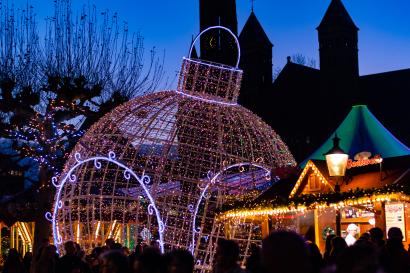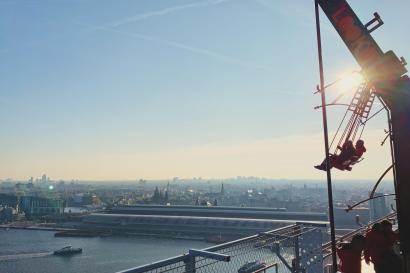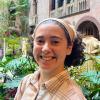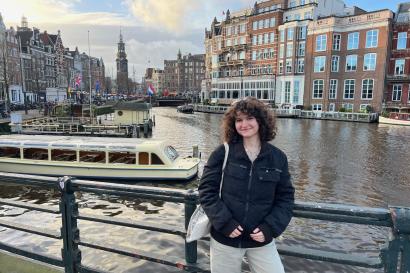
It’s December, and even though I’m thousands of miles away from home, I can’t seem to escape the Jackson 5 Christmas album.
The cafe where I work in St. Paul (a Caribou Coffee, which I have to describe to my Dutch friends as “like Starbucks” because it’s so different from anything else you can find in the Netherlands) plays this music almost exclusively during the holiday season, and although it’s definitely festive, my coworkers and I quickly grow tired of young Michael Jackson belting “Santa Claus is Comin’ to Town” and “I Saw Mommy Kissing Santa Claus” every couple of minutes. Here, though, it’s almost comforting; sitting in a cafe chipping away at a 15-page research paper (another symbol of December: finals season!), hearing that familiar falsetto instantly brought a smile to my face.
The holiday season is out in full force all over Europe. There may not be any snow on the ground – a very welcome change from Minnesota, I have to say – but twinkling lights all across the city are making the 5:00 sunsets bearable, and there’s always the option of buying an oliebol from the carts on the street to warm up. Christmas markets of all sizes are popping up all over the continent, drawing international crowds and brewing huge vats of mulled wine and hot chocolate to accommodate (I’ve been to three so far – but more on that later). I’ve been enjoying the holiday festivities for a bit longer than my friends in the States, though, because the Dutch do it a little differently: Sinterklaas.
Chocolate Letters and Pepernoten
Sinterklaas is the Dutch version of Christmas, celebrated on December 5. Sinterklaas – St. Nicholas, who predates Santa like oliebollen predate doughnuts – “arrives” in the country from Spain, where he “lives,” with a big parade on a set day every year. There’s a national parade and city-specific parades; I didn’t attend any, but I still got my share of fanfare in the following weeks. After the parade, which was on November 17, the entire city is decked out in lights, paper decorations, and traditional sweet treats.
Sinterklaas fills shoes with candies and presents while children sleep after he’s arrived in the country, and on December 5th, the families really celebrate. There’s usually a ‘white elephant’ (to use an American term) gift exchange, and everyone receives a chocolate letter, usually the first letter of their first name. In the month leading up to Sinterklaas, then, grocery stores and gift shops are fully stocked with chocolate letters, or at least the chocolate ‘S,’ representing Sint himself. Tony’s Chocolonely, the Dutch fairtrade chocolate brand I’ve become addicted to, sells the letters with a special addition: pepernoten cookies.
Pepernoten, translated as peppernuts but more like little ginger cookies, are also special to the season. Christmas markets have them out in little bowls for shoppers to snack on, and there’s a display of them in every grocery store. Some brands even have entire stores dedicated to just the cookies, which can be plain, gluten-free, or covered in different coatings like chocolate or caramel. Plus, the Van Delft store always has free samples. I’ve had to avoid buying myself a bag because they’re so easy to snack on, but you bet there will be at least one in my suitcase.
Once Sinterklaas ends, the Netherlands transfers to Christmas season. My Dutch professor told us Christmas is more of a traditional religious holiday here, with a visit to church and a family dinner, but having a tree and a plate of cookies for Santa is becoming more popular. It’s certainly big in neighboring countries like Germany, though, as I’ve discovered by visiting markets in the past few weeks.
Hot Cocoa and Potato Pancakes
I’ve been to three big Christmas markets so far: in Maastricht, the Netherlands (about the furthest south you can go, two-and-a-half hours from Amsterdam by train), Cologne, Germany, and Florence, Italy. Each were very unique and special to their host cultures, but with some unifying characteristics like decor, food, and some commodities. I absolutely loved each of them, and definitely felt at home in the crisp December winds despite snow-free surroundings.
Cologne’s market was my favorite, and the biggest by far. While Maastricht’s and Florence’s markets took up (albeit very big) town squares, Cologne’s covered the entire city. It’s no question why this is one of the Christmas destinations in Europe: instead of one big market, there are several individual ones, each with a different aesthetic theme. If you want a drink, from mulled wine to hot chocolate, it comes with a keepsake mug, each themed after the market they came from. I got two: one from their oldest market, in front of the massive cathedral, and one from a smaller market filled with gnomes. We also spent a lot of time in the harbour market and the market with a giant weihnachtspyramide (spinning wooden candle holder) in the center. Tourists and locals alike wandered the streets during the day and after sunset, when the lights were up in full force. I can’t imagine living in a place so universally dedicated to the holiday – it was honestly magical.
The stands at the markets were wood, decorated with holly, and bustling with customers. It was very crowded (we went on a Sunday, after all), but that didn’t stop us from admiring at ornate ornaments, art, and animatronic winter scenes. We snacked on a potato pancake sort of food called kartoffelpuffer, Bavarian spaetzle, and bratwurst as we market-hopped through the city. We didn’t actually buy much, but that wasn’t really the point of the trip – it was the draw of being absolutely immersed in Christmas that led us to plan the trip two months in advance.
Cologne is conveniently only four hours from Amsterdam by bus. The bus schedule itself was less convenient: we ended up having to leave the city at 3:00am, but thankfully our bus station was the airport, so it was fully lit, heated, and had a 24-hour McDonald’s to keep us company. The time my friends and I spent wandering the city and snacking was well-worth the odd travel accommodations, though, and I hope I can go back to Cologne for another Christmas sometime in the future.
Smaller Markets
I was very lucky to take the train trip to Maastricht with my family when they visited over Thanksgiving. It was the opening day of ‘Magical Maastricht,’ and the whole city was out and about – a market seller told us that most locals take the day off from work to celebrate. There was a giant ferris wheel in the center of the square, another traditional church twice the age of the United States behind it, and the heartwarming smell of poffertjes, bratwurst, and fried mushrooms filling the air, accompanied by Michael Bublé’s holiday album. This was the first market I visited, and it did not disappoint.
Like I would also learn in Cologne and Florence, people come from all over Europe to sell their products at these markets. Maastricht is in the ‘tail’ of the Netherlands, very close to Belgium and not far from Germany or even France, so it drew a huge crowd. I could see the differently international influences in the signs, all in Dutch, English, and French (which is spoken in a lot of Belgium), and in the food. Belgian waffles were sold next to German sausages and Dutch oliebollen, and art sellers were quick to tell us how far they’d traveled. One woman told us she’d moved to the Netherlands from Russia a few years back, and quickly sold my mom on a Christmas-themed Russian nesting doll, with a tiny Christmas tree at the center. The sense of community, like at the other markets, was incredibly strong.
Florence’s market, overlooked by the beautiful Basilica of Santa Croce, sold similar gifts with a similar feel, but with a greater emphasis on the international aspect. It seemed like every booth was owned by a citizen of a different country, from Italy to England, France, Germany, and even the Netherlands – I even had a quick conversation with a man making poffertjes in Dutch, the success of which delighted both of us.
I was in Florence visiting a friend spending her semester at SACI, an art school, and she’d never been to a Christmas market before. Needless to say, she was delighted, and we sipped hot apple cider for almost an hour while walking back and forth through the stalls.
December Promises
Even across the world, my final exams are made bearable by the promise of the holidays to come. There are Christmas trees in my building, the Centraal Station, the IES Abroad Center, and all over the city. The Sunday markets, which have not let up in the face of winter winds, are starting to be themed for the holidays, and ice skating rinks are popping up in parks and the Museumplein, flanked by frites stands and bundled-up children using chairs to steady themselves. There may not be snow on the ground or dangerously-cold temperatures freezing my hair each morning, but it feels like I’m back in Minnesota.
One final aspect of December which I’ve come to know in recent years is the promise of returning home for winter break. I’ve got a week left in Amsterdam now, and I’m in denial. I’m planning on going to markets in the days leading up to my departure as if I won’t already be struggling to fit everything into my suitcase. I’m slowly checking spots off my ‘goodbye’ list, but I know it’s just “tot ziens.” I will be back in Amsterdam sometime – and though I’d love to see the spring tulips, December in Europe is definitely growing on me.

Betsy Barthelemy
<p>I was very fortunate to have the opportunity to briefly study abroad in Japan (several cities) and do community service work in Riobamba, Ecuador, while in high school, effectively biting me with the travel bug. At school, I major in English and minor in anthropology, but also enjoy taking classes in linguistics, photography, Japanese, and theater. When I’m not in class, I’m probably in a chorale rehearsal, helping edit Macalester’s newspaper, working at the cafe across the street, or baking cookies.</p>







